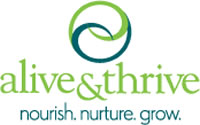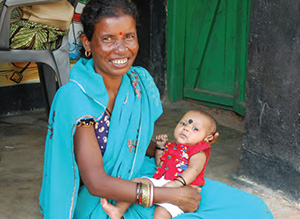The “Great SBCC Example” below was featured during the Designing the Future of Nutrition Social and Behavior Change Communication Conference and can be used as a learning aid or as an illustration of key concepts from country-level experts attending the conference.


Background
Few attempts have been made to scale up infant and young child feeding (IYCF) interventions. The initial mandate of Alive & Thrive (A&T) was to design, implement, and test strategies that could be brought to scale to improve breastfeeding and complementary feeding among children in Bangladesh, Ethiopia, and Vietnam.
Description of Intervention
A&T implements multi-component programs that make strategic use of data to plan, assess, and evaluate program impact to improve child feeding practices. The aim is to disseminate the models and the learnings widely, encouraging adaptation or replication of at-scale implementation in other settings. Each program consists of four components: (a) advocacy, (b) interpersonal communication and community mobilization, (c) mass communication, and (d) strategic use of data. In three countries, A&T set out to create proof of concept that IYCF programs can be delivered at scale, resulting in widespread behavior change.
Design Process
Data were strategically used throughout the lifetime of the program to inform, shape, and refine the design, implementation, messages, and management of each country program. A similar formative research design process was conducted in each country, varying slightly depending on program objectives. Formative research results led the program design in different directions in each country.
For example, formative research methods in Bangladesh were adapted from the ProPAN (Process for the Promotion of Child Feeding) research methodology developed by the Pan American Health Organization/World Health Organization and included surveys, focus group discussions, observations, food attribute exercises to identify perceived benefits and barriers to consuming particular foods, and trials of improved practices (TIPs) to test the feasibility of recommended behaviors. The research was conducted with a variety of audiences, including mothers, family and community influencers, and health personnel. The research identified barriers, facilitators, perceptions, practices, and beliefs regarding IYCF. A media audit was also conducted, to understand the media landscape, identify the most popular media outlets, determine which audiences would be best reached through mass media, and identify the most appropriate channels and dissemination plans.
Design Strategies
Interventions in the three countries were designed to respond to the findings of formative research and media audits, including these insights:
- Lack of knowledge, confidence, and support affect breastfeeding practices: Barriers to exclusive breastfeeding and early initiation of breastfeeding include perceptions of insufficient breast milk, lack of knowledge on importance of early breastfeeding and colostrum, and lack of support after delivery.
- Lack of knowledge also hinders appropriate complementary feeding practices: Barriers to appropriate complementary feeding include mothers’ lack of knowledge and understanding of importance, beliefs regarding suitable foods, and practices regarding unhealthy snacks.
- Mothers’ feeding practices are determined by several motivators, including their child’s health/brain development, their child’s acceptance, and the mother’s convenience.
- Close contacts have sway over mothers’ practices: Influencers on mother’s behavior are grandmothers, husbands, and doctors—rarely community health workers.
- TV is key for media outreach campaigns: Media sources are primarily TV programs; collective viewing is popular among those who do not own a TV.
Published research and national surveys were also used to shape program design; rollout was informed by pilot studies, feasibility studies, and implementation research.
Implementation Strategies1
Implementation strategies, included:
- Use data-driven program design to (a) deliver previously proven nutrition interventions, taking advantage of research data, (b) address suboptimal IYCF practices based on survey data, and (c) promote behaviors that formative research highlighted as acceptable and feasible for mothers to practice.
- Set ambitious, measurable goals to which country teams are held accountable, while being encouraged to innovate and adapt as necessary to get results.
- Prioritize early planning for evaluation, allowing for implementation of a rigorous evaluation of programs.
- Ensure frequent collection of data on service delivery outputs and estimated coverage to understand whether interventions are being delivered as planned and whether they are achieving results.
- Ensure adequate resources for monitoring, learning, and evaluation, ranging from 12–19 percent of in-country costs.
Evidence of Effectiveness
Program evaluation was carried out using a cluster-randomized design at baseline and endline in intervention and comparison areas. Results showed that A&T’s multi-component model achieved behavior change when implemented at scale, as demonstrated by the early results of the process evaluation conducted in 2013 (one year before the endline). The results show a difference of 24 percentage points between exclusive breastfeeding in “intensive” areas (where the interventions included interpersonal communication and mass media) and “non-intensive” or mass media–only areas in Bangladesh, from 2010–2013. Additionally, the percentage of children meeting minimum dietary diversity recommendations in Bangladesh doubled. In Ethiopia, from 2010–2013, there was an 8-percentage-point increase in exclusive breastfeeding in A&T intervention areas. The percentage of children aged 6–23 months consuming four or more food groups (minimum dietary diversity) and the percentage of children aged 6–23 months fed the minimum recommended number of times (minimum meal frequency) doubled. In Vietnam, in areas where only a mass media campaign was used, rates of exclusive breastfeeding increased by 24 percentage points (from 18% to 42%) from 2010–2013. In areas with mass media campaigns and interpersonal counseling through social franchises, rates of exclusive breastfeeding increased by 44 percentage points in three years.
In total, the estimated reach, based on 2013 data, shows that in Bangladesh, 1.7 million mothers of children under two years were counseled on IYCF and 6.5 million were reached by the mass media campaign. In Ethiopia, 2 million mothers of children under two years were reached through interpersonal communication, radio, or both. In Vietnam, 2.3 million mothers of children under two years were reached through interpersonal counseling, mass media, or both. Costing analysis and cost-effectiveness analysis are forthcoming.
Lessons Learned
- Effective implementation requires frequent data from a variety of sources. Data from scientific literature, nationally representative surveys, formative research, and routine information systems are needed to inform decision-making for large-scale programs, enabling them to adapt as needed for maximum impact.
- Timing of data collection matters. Relying on baseline and endline data is not sufficient to inform decision making. Investment in a variety of data is required to make the information available to managers in “real time,” or as close to it as possible, to encourage strategic use of data.
- Data can wield considerable convening power. Sharing data facilitated discussions with policymakers in Vietnam, helped build consensus about priority IYCF behaviors to promote in Bangladesh, and shaped opinions about the direction of nutrition programming in Ethiopia.
Key Takeaways for Nutrition Social and Behavior Change Communication
- Include investment in outcome monitoring.
- Flexible, rigorous, and continuous monitoring and evaluation can be used to adapt programming as needed.
Organization/Project: Alive & Thrive
Alive & Thrive is an initiative to save lives, prevent illness, and ensure healthy growth and development through improved breastfeeding and complementary feeding practices. Good nutrition in the first 1,000 days is critical to enable all children to lead healthier and more productive lives. In its first five years (2009–2014), Alive & Thrive demonstrated that innovative approaches to improving feeding practices could be delivered with impact and at scale in three contexts: Bangladesh, Ethiopia, and Vietnam. Alive & Thrive is now supporting the scale up of nutrition programs by applying and adapting tested, proven approaches and tools in contexts such as Burkina Faso, India, and Southeast Asia. With its emphasis on learning and innovation, Alive & Thrive is expanding its focus in Bangladesh to maternal nutrition and taking a more multisectoral approach in Ethiopia.
A&T is funded by the Bill & Melinda Gates Foundation and the Governments of Canada and Ireland. Managed by FHI 360, Alive & Thrive builds on lessons learned through its partnership with seven organizations.2